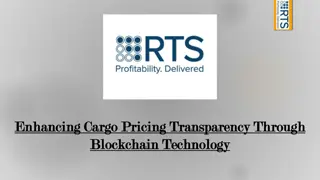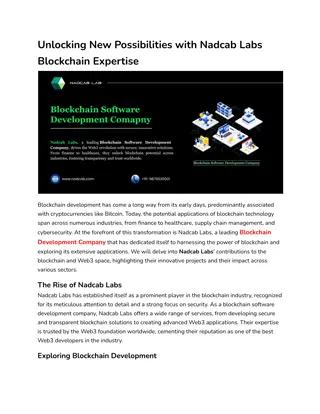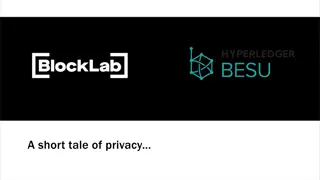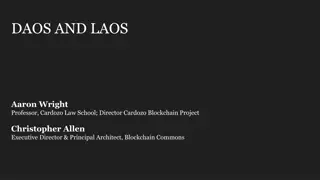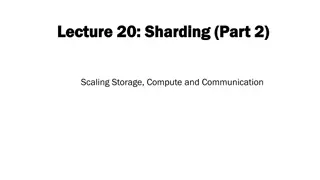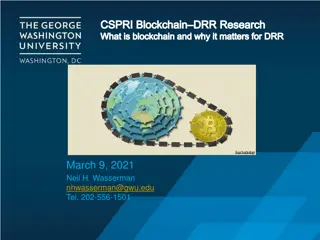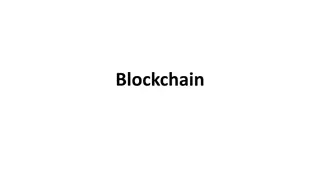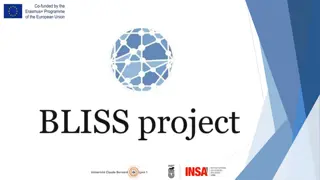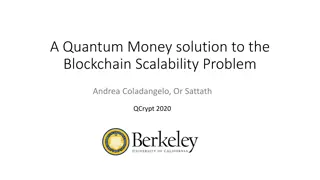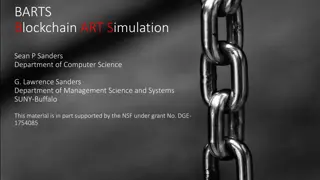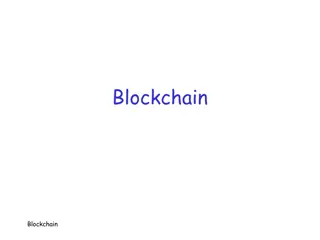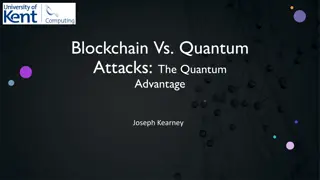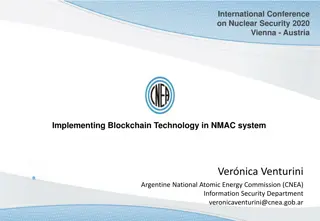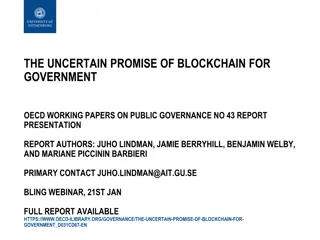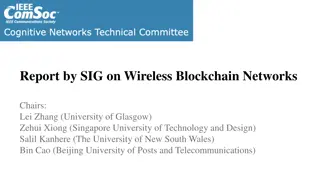Understanding Blockchain Data Structures and Hyperledger Implementation
Blockchain technology offers valuable properties but faces challenges with privacy and data deletion. Blockmatrix, a data structure, provides integrity protection with controlled edits, making it a viable solution for distributed database applications. This summary highlights the conflict between blockchain's immutability and privacy concerns, along with the potential for different approaches in distributed ledger technology. Deletion in blockchains poses a significant problem due to the need for chain consistency, impacting data integrity and privacy compliance.
Download Presentation

Please find below an Image/Link to download the presentation.
The content on the website is provided AS IS for your information and personal use only. It may not be sold, licensed, or shared on other websites without obtaining consent from the author. Download presentation by click this link. If you encounter any issues during the download, it is possible that the publisher has removed the file from their server.
E N D
Presentation Transcript
Blockmatrix Data Structure and Hyperledger Implementation Rick Kuhn Josh Roberts US National Institute of Standards and Technology Computer Security Division kuhn@nist.gov joshua.roberts@nist.gov
TL;DR Summary of talk Blockchain has valuable properties, but conflicts with privacy and exception management can t delete private data can t correct error entry Data structure called blockmatrix provides integrity protection of blockchain, but allows controlled edits for privacy, corrections Blockmatrix is a component for distributed database solutions; it is one design option, blockchain is another, choice depends on application needs Drop-in compatibility with Hyperledger Fabric
Blockchain/distributed ledger Blockchain/distributed ledger could use a different approach could use a different approach for many applications for many applications Kuhn, R., Yaga, D., & Voas, J. (2019). Rethinking distributed ledger technology. IEEEComputer, 52(2), 68-72. Kuhn, R. (2018). A Data Structure for Integrity Protection with Erasure Capability. National Institute of Standards and Technology. Stavrou, A., & Voas, J. (2017). Verified time. IEEEComputer, 50(3), 78-82.
Structure of a Traditional Blockchain Structure of a Traditional Blockchain Blockchain has been defined as "an open, distributed ledger that can record transactions between two parties efficiently and in a verifiable and permanent way".
Why is deletion a problem for blockchains? Why is deletion a problem for blockchains? Because it is supposed to be change to one block changes hashes of all; provides integrity protection Hashes provide assurance that information in every other block is unchanged if one block is modified If we have to delete a block, hash values for others are no longer valid; requires entire new chain Don t want to create a new chain
Why is this a problem for applications? Why is this a problem for applications? The permanence/immutability property that makes blockchain technology useful also leads to difficulty in supporting privacy requirements Privacy rules such as those of European Union General Data Protection Regulation (GDPR) requires that all information related to a particular person can be deleted at that person's request personal data, defined as "any information concerning an identified or identifiable natural person" - data for which blockchains are designed to be used "Personal data which have undergone pseudonymisation, which could be attributed to a natural person by the use of additional information should be considered to be information on an identifiable natural person."
What is the rationale for blockchain properties? What is the rationale for blockchain properties? Blockchain and proof-of-work protocol were designed to solve the problem of double spending in cryptocurrencies. As with all design choices, blockchain properties have tradeoffs Proof of work provides an ordering guarantee, => at the expense of enormous processing time and expense Linked hash records provide trust and integrity guarantee, => at the expense of losing modification or erasure mechanisms required for privacy
How well do blockchain properties apply to traditional distributed data management applications? Cryptocurrency Finance, supply chain, e-commerce, etc. 1. Partial anonymity ID required for contracts or government regulation 2. Public access/transparency Controlled access 3. Small transaction size Range of message sizes up to large documents, images 4. Immutable records Changes and deletions, often required by law 5. Proof of work Flexible consensus models 6. Block ordering guarantees Timestamps often required 7. Decentralization Same in many applications 8. Replication Same in many applications 9. Data integrity guarantees Same in many applications
Key points Key points blockchain properties blockchain properties Blockchain was designed to solve the problem of double-spending in digital currency Blockchain s desirable properties have made it attractive for distributed system applications other than cryptocurrency But many of its features make it very unattractive for distributed applications Consequently much current research in blockchain is devoted to getting around its built-in properties We can provide integrity guarantees and sequencing like blockchain but with low resource consumption and allow revising blocks
Can we try something else? Datablock matrix uses two hash values per block instead of a linked chain Java or Go components available as open source Incorporated into Next Gen Access Control practical demo Hyperledger component implementation nearing completion Verified time high resolution time stamp instead of ordering guarantee
Changing data in blockchain vs. Changing data in blockchain vs. datablock datablock matrix matrix Blockchain Initial data entry -> transaction in a block Modification -> new transaction keyed to previous Use key to new value, not allow use of previous, obsolete, value Dependent on proof of work to ensure sequence Datablock matrix Initial data entry -> transaction in a block Modification -> delete/replace transaction by owner Use previous key, new value found in block Sequence not needed since only one value exists
What are attempts at solving this problem? What are attempts at solving this problem? Don t put personal data on blockchain Pseudo-anonymized data are still considered personal Even if not directly tied to a person dynamic IP address can be considered personal if it can be indirectly tied Financial transactions are obviously personal data Encrypt data and destroy key to delete Data must be secure for decades Advancements in cryptography usually compromise old crypto e.g., quantum computing puts current public key systems at risk
What are What are blockmatrix blockmatrix constraints and assumptions? constraints and assumptions? Hash integrity protection must not be disrupted for blocks not deleted Must ensure auditability and accountability Designed for permissioned/private distributed ledger systems such as supply chain, medical records management, electronic funds transfer Provide distributed consensus and guaranteed shared view
New data structure solution: a New data structure solution: a datablock datablock matrix matrix A data structure that provides integrity assurance using hash- linked records while also allowing the deletion of records Stores hashes of each row and column => each block within the matrix is protected by two hashes Suggested use for private/permissioned distributed ledger systems
How does this work? How does this work? Suppose we want to delete block 12 0 1 2 3 4 disrupts the hash values of H3,- for row 3 and H-,2 and column 2 0 1 3 7 13 H0,- 1 2 5 9 15 H1,- blocks of row 3 are included in the hashes for columns 0, 1, 3, and 4 2 4 6 11 17 H2,- 3 8 10 12 19 H3,- blocks of column 2 are included in the hashes for rows 0, 1, 2, and 4 4 14 16 18 20 H4,- H-,0 H-,1 H-,2 H-,3 H-,4 etc.
Datablock Datablock Matrix Population Algorithm Matrix Population Algorithm Algorithm Basic algorithm is simple, many variations possible Implemented as Java code Github project Block ordering provides desirable properties
Data Structure Properties Data Structure Properties Balance: upper half (above diagonal) contains at most one additional cell more than the lower half. Hash sequence length: number of blocks in a row or column hash proportional to ? for a matrix with N blocks, by the balance property. Number of blocks: The total number of data blocks in the matrix is ?2 ? for k rows/columns since the diagonal is null. Block dispersal: No consecutive blocks in same row or column, in sector 0 (below diagonal) or sector 1(above) for b mod 2 for block b
Structure can be extended to multiple dimensions Block dispersal for 3 dimensions Location in sectors 0..5 according to b mod 6 for block b
Comparison Summary Comparison Summary Blockchain New approach Integrity protection Transparency global Editable, timestamps Integrity protection Transparency global Permanence, proof of work
So what? Why use this data structure? So what? Why use this data structure? Enlarge the market for blockchain Solve the conflict between blockchain and privacy regulations Allow for exception management Replace network communication with local data You can obviously do this with conventional database functions New data structure adds integrity checks as in blockchain Our goal is to make this a basic easy-to-use component for distributed database design.
NIST blockchain decision flowchart Distributed ledgers provide a historically consistent data store. If you don t need that, you don t need a distributed ledger NO Do you need a shared, consistent data store? CONSIDER: Email / Spreadsheets YES Your data comes from a single entity. Distributed ledgers are typically used when data comes from multiple entities. NO Does more than one entity need to contribute data? CONSIDER: Database CAVEAT: Auditing Use Cases Uses handled by blockmatrix that cannot be done in blockchain AUDITING YES NO Data records, once written, are never updated or deleted? YES You should not write sensitive information to a blockchain that requires medium to long term confidentiality, such as PII, even if it is encrypted CONSIDER: Encrypted Database OR blockmatrix NO Sensitive identifiers WILL NOT be written to the data store? YES Are the entities with write access having a hard time deciding who should be in control of the data store? YES Are the entities with write access having a hard time deciding who should be in control of the data store? YES If there are no trust or control issues over who runs the data store, traditional database solutions should suffice CONSIDER: Managed Database NO NO Do you want a tamperproof log of all writes to the data store? NO If you don t need to audit what happened and when it happened, you don t need a distributed ledger CONSIDER: Database NO Do you want a tamperproof log of all writes to the data store? YES YES You may have a useful data block matrix use case You may have a useful blockchain use case
What about tech transfer? What about tech transfer? Received NIST Technology Maturation Acceleration Program funding for technology transfer and commercialization Integrating with Next Generation Database Access Control Patent approved assures availability of technology Hyperledger component nearing completion
Hyperledger blockmatrix implementation Hyperledger is widely-used open source project started by IBM, Intel, and SAP Hyperledger Fabric - intended for large distributed systems Blockmatrix to be dynamic, increasing capacity as more blocks are added Designed to use existing API as closely as possible add blocks in same manner as adding to blockchain Additional API functions to delete/edit, manage access control
Block Structure for Hyperledger Blocks store key value pairs instead of transactions The key is stored in the block header along with the block number The value is stored in the block s data field No need to store the hash of the previous block
BlockchainInfo vs BlockMatrixInfo message BlockchainInfo { uint64 height = 1; bytes currentBlockHash = 2; bytes previousBlockHash = 3; } message BlockMatrixInfo { uint64 size = 1; uint64 blockCount = 2; repeated bytes rowHashes = 3; repeated bytes columnHashes = 4; }
Hyperledger Example
Hyperledger Example AddBlock(2, key2 , value2 )
Hyperledger Example AddBlock(3, key3 , value3 )
Hyperledger Example DeleteBlock(2)
Hyperledger Example UpdateBlock( key3 , new_value )
Hyperledger Integration Summary Blocks store key, value pairs No need to store hashes Instead of transactions, values are stored Keys are stored in header Each block still has a number
Where are we now? Where are we now? Integrate with Next Gen Database Access Control - completed Implement blockmatrix as plug-and-play component in Hyperledger Fabric nearly completed Demonstrate logistics/supply chain, clinical trials, electronic funds transfer - also new European Central Bank report says Hyperledger Fabric fits needs of digital euro can blockmatrix help ?
More information: More information: Kuhn, R., Yaga, D. and Voas, J., 2019. Rethinking Distributed Ledger Technology. Computer, 52(2), pp.68-72. Stavrou, A. and Voas, J., 2017. Verified time. Computer, 50(3), pp.78-82. Kuhn, D. R. (2018). A Data Structure for Integrity Protection with Erasure Capability. https://csrc.nist.gov/publications/detail/white-paper/2018/05/31/data-structure- for-integrity-protection-with-erasure-capability/draft Project site with links to source code and publications https://csrc.nist.gov/Projects/enhanced-distributed-ledger-technology Acknowledgements Jeff Voas, Dylan Yaga, David Ferraiolo, NIST Joanna DeFranco, Penn State University Temur Saidkhodjaev, University of Maryland College Park Arsen Klyuev, Johns Hopkins University Gokhan Kocak, Asena, Inc.


